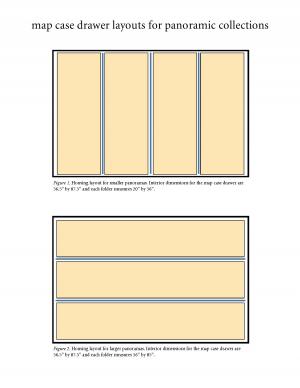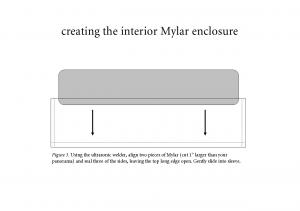While panoramic photographs provide us with a unique and often breathtaking view of a landscape, such as the photographs of the Canadian Rockies in the Charles D. Walcott Collection, they also provide a housing challenge for archives. While flat storage is typically preferred for oversized items, often times these panoramas are rolled to save space. But if they are rolled too tightly or folded, it can lead to long-term preservation concerns, as well as access issues for researchers. Check out our series of post entitled, “Panorama Panic! A Sticky Situation,” to learn more about the conservation treatment of a particularly unruly rolled panoramic photograph.
Over the past year, the Archives has hosted two interns who’ve focused primarily on the inventory, reorganization, and rehousing of oversized collections stored in our map case drawers. Some of the collections contain architectural drawings, reproductions, photographs, and – you guessed it – panoramas! We quickly realized that these panoramic photographs, drawings, and maps required something a little more robust than our usual 20-point folders. Some of the panoramas measured upwards of six feet long, and simply could not be handled safely without additional support. Our colleagues at the New York University (NYU) Libraries tackled this issue several years ago with their map cases, and we used their housing and drawer organization as inspiration for our own.
Based on the interior dimensions of our map case drawers, we determined that two standard sizes would be the best fit for our drawers – 20 inches x 56 inches (oriented front to back) and 16 inches x 85 inches (oriented side to side). Any panorama longer in length than 85 inches will be rolled for long-term storage.


Now that we have standard sizes based on the sizes of our drawers and collections, we are able to start constructing the housing. The base is made of archival E-flute corrugated board, cut to the desired standard size. Note: You can get archival corrugated board measuring 96 inches in length, which is necessary for our longer panoramas. It’s important to use one solid piece of board (rather than piecing two together) in order to maintain the integrity of the base support.
The next step is to create an inner enclosure for the panorama using uncoated polyester terephthalate film, also known as Mylar®. Two pieces of Mylar are cut to the size of the panorama, adding one inch to both sides. Sealing three sides using the ultrasonic welder, the top long edge is left open to slide the panorama into the enclosure.

Have you ever wondered what to do with all of those scraps of Mylar you inevitably end up with over the years? You’re in luck! This housing is a great opportunity to use up some of those scraps by creating photo corners to secure the panorama to the corrugated board base. All you need is a piece of Mylar that’s 1 inch by (at least) 2 inches. Fold over both sides to create a triangular “corner.” Archival double-sided tape is used to secure these to the base at all four corners, orienting the folded flaps towards the board.
Lastly, a protective cover mat is created cut to the dimension of the corrugated board base, adding 2 inches to the height. This two-inch section is folded over, creased using a bone folder, and secured to the back of the board using archival double-sided tape. Each cover is labeled in the lower right-hand corner with the collection and folder number.
Panoramas can be a challenge for both preservation and access. However, the supportive base allows them to be safely moved for researchers and the Mylar inner enclosure and corner restraints provide support to prevent future warping and curling in storage. This simple solution can take a collection from unwieldy and space-consuming to manageable and accessible.
Related Resources
An ‘Intern’duction to Storage of Oversized Archival Collections, The Bigger Picture, Smithsonian Institution Archives
Panoramic Panic! A Sticky Situation, Part 1, The Bigger Picture, Smithsonian Institution Archives
The Quest for Walcott's Quarry, The Bigger Picture, Smithsonian Institution Archives
Produced by the Smithsonian Institution Archives. For copyright questions, please see the Terms of Use.

Leave a Comment